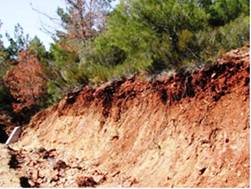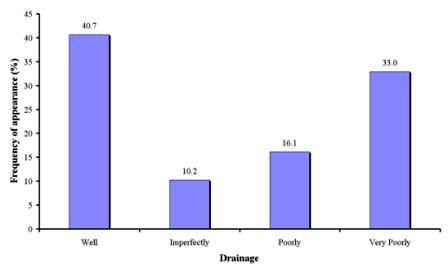Soil drainage
Soil drainage is related to how rapidly excess water leaves the soil by runoff or internal drainage. Internal drainage is referred to downward movement of water into the soil profile and it affects the redistribute of soil water to lower depths of the profile, thereby increasing the water content at the subsoil. Drainage is classified in classes according to the term which generally describes the condition of how long the soil is free of saturation, for example in a well drained soil water is removed very rapidly and no occurrence of internal free water is observed. On the contrary, in a poorly drained the soil is saturated for a long period resulting in the formation of mottles of iron and manganese in the upper 30 cm of the soil, or grey colors of reducing conditions, with a permanent water table usually at a depth greater than 75 cm. Poor drainage is not associated with desertification, but with the loss of profit from cultivated plants. Excessive drainage in coarse textured soils, on the other hand, may contribute to desertification.
Soil drainage conditions for the purpose of the this study have been defined on the basis of the depth of hydromorphic features such as iron or manganese mottles or gray colors, and depth of the groundwater table. The following drainage classes have been distinguished:
- Very well to well drained soils: Soils with any Fe or Mn mottles or gray colors at some depth greater than 100 cm from the soil surface. The soil is not wet enough near the soil surface or the soil does not remain wet during the growing period of the plants. Water is removed from the soil rapidly (Fig. 15).
- Moderately well to somewhat poorly drained soils: Fe, Mn or gray mottles are present in the soil, at some depth between 30 and 100 cm from the soil surface. The soil is wet enough near the soil surface or the soil remains wet during the early growing period of the plants. Water is removed from the soil slowly.
- Poorly drained soils: Mottles of Fe and Mn are present in the upper 30 cm of the soil, or gray colors of reducing conditions are present. A permanent water table usually exists at a depth greater than 75 cm. In some of these soils the ground water may reach to the surface during the wet period of the year. Water is removed from the soil so slowly that the soils are wet at shallow depth for long periods.
- Very poorly drained soils: Mottles of Fe and Mn are present in the upper 30 cm of the soil, or gray colors of reducing conditions are present. A permanent water table usually exists at a depth less than 75 cm. In many of these soils the ground water may reach to the surface during the wet period of the year. Water is removed from the soil so slowly that the soils are wet at shallow depth for long periods.


Fig. 15. Example of well drained soil (left) and very poorly drained soil (right)
Soil drainage has been described in 446 field sites, corresponding to 6 study sites (Table 3). Soil drained conditions are related to physiographic and topographic conditions. Soils on slopping areas are usually well drained. On the contrary, soils found in plain areas located at the lower concave physiographic positions close to water bodies or having a ground water table close to the soil surface are usually poorly drained. The obtained data in part of the study sites (Table 3) showed that well drained soils are dominant covering 40.7% of the total study field sites (Fig. 16). Such soils have been mainly found in the study sites of Konya, Karapinar plain-Turkey, Novij Saratov-Russia, and some in Crete-Greece, and Boteti Area-Botswana. The next important class identified is very poorly drained soils covering 33.0% of the study field sites, located mainly in Djanybek-Russia, and in some cases in Crete-Greece, and Boteti Area-Botswana. Poorly drained soils cover 16.1% of the study field sites located mainly in Novij Saratov-Russia, and in Crete-Greece. Areas with poorly and very poorly drained soils are sensitive to desertification under semi-arid or dry-subhumid climatic conditions due to soil salinization. Finally imperfectly drained soils were mainly found in some sites of Boteti Area-Botswana, Crete, Greece, Nestos Basin Maggana-Greece, and Novij Saratov-Russia.

Fig. 16 Distribution of soil drainage conditions prevailing in the study field sites